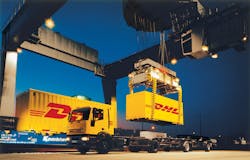A survey of the 30 CEOs atop some of the world’s largest third party logistics (3PL) companies discerned broad confidence regarding projected growth for both revenues and profits.
However, serious challenges – especially in terms of the increasingly global shortage of truck drivers and rising regulatory burdens – remain athwart the industry’s future path, they said.
The 22nd annual Survey of Third-Party Logistics Provider (3PL) CEOs, sponsored by Penske Logistics, discerned that more than 80% of the companies surveyed were profitable last year, with those 20 3PLs generating some $40 billion in combined revenue overall.
CEOs from 3PLs in North America and Asia-Pacific forecasted three-year revenue growth averages for their companies of 7.86% and 11.5%, respectively, with European 3PL CEOs forecasted 5.33% growth over the same period.
Yet 3PL CEOs in Europe and North America especially continue to be concerned by the truck driver shortage and talent management issues spanning the industry, noted Robert Lieb, professor of supply chain management at Northeastern University’s D’Amore-McKim school of business and principal author of the survey report.
Some 26% of North American CEOs and 60% percent of Asia-Pacific CEOs cited the worsening driver shortage to be a key factor impacting the global 3PL market, he said.
Additionally, an inflexible workforce, oppressive regulations, rapidly changing market conditions, increased costs for technology upgrades and capacity constraints are dynamics these CEOs believe will affect the global 3PL industry over the next several years, Lieb’s poll found.
Merger and acquisition (M&A) activity is also on the rise within the 3PL sector, he noted, with 10 major acquisitions by 3PLs totaling $18 billion occurring since early 2014.
Lieb argued that this is “leading to a significant restructuring of the industry” in many markets, which will require “substantial effort” on behalf of those 3PLs to integrate those operations post-acquisition.
It will also result in significant brand confusion in the marketplace that will have to be addressed by those companies, he added, with many of the CEOs involved in this year’s surveys stating that this “recent wave” of M&A activity generating more “defensive acquisitions” by other 3PLs.
Other trends highlighted by Lieb’s survey include:
- Ongoing growth in e-commerce activity: E-commerce now accounts for an average of 11.85% of North American 3PL revenue, with CEOs predicting an increase to 20.85% in three years. In Europe, average e-commerce revenues now account for 5.33% of 3PL revenues, which is projected to grow to 9% in three years. The CEOs polled added that the expansion of 3PL technology support for e-commerce was critical for the industry’s ongoing success.
- West Coast ports will remain dominant freight entry points: In early 2015, one of the worst labor conflicts in recent history, labor slowdowns at major West Coast ports, created significant supply chain issues for carriers, 3PLs, and shippers, particularly in the North America and Asia-Pacific regions. Yet ddespite their customer’s problems with the affected ports, those 3PL CEOs polled said few of them will significantly change their degree of reliance upon those ports in the future.
- Lower oil prices a boon: In North America, 80% of 3PL CEOs polled said the global decline in oil prices had a positive impact on key customers, particularly with regard to lower transportation costs. CEOs agree that lower oil prices are not likely to have a significant impact on the environmental sustainability programs of 3PLs.
- Economic uuncertainties rising for Europe, Asia: Changing economic conditions are impacting the 3PL industries in Europe and Asia-Pacific, with European 3PL CEOS stating that the logistics market there “has not rebounded significantly” in the past year. The majority of Asian-Pacific CEOs cite the declining gross domestic product (GDP) growth rate in China as an industry dynamic impacting the region’s 3PL industry, with additional responses citing infrastructure issues in the region’s emerging markets and difficulties in developing accurate economic forecasts.
- Uber-model viewed as a freight threat: Ride-sharing companies, most notably Uber, are believed by those 3PL CEOs polled to “potentially pose a threat” to aspects of the logistics industry in the future. As an international transportation network with technology at its core, Uber operates in more than 60 countries and has attracted significant investment capital. The company could eventually pose a threat to 3PL business by providing last-mile delivery services and/or becoming a small LTL carrier and taking business away from small-volume couriers, 3pl CEOs noted in the survey.
About the Author
Sean Kilcarr
Editor in Chief
Sean Kilcarr is a former longtime FleetOwner senior editor who wrote for the publication from 2000 to 2018. He served as editor-in-chief from 2017 to 2018.
